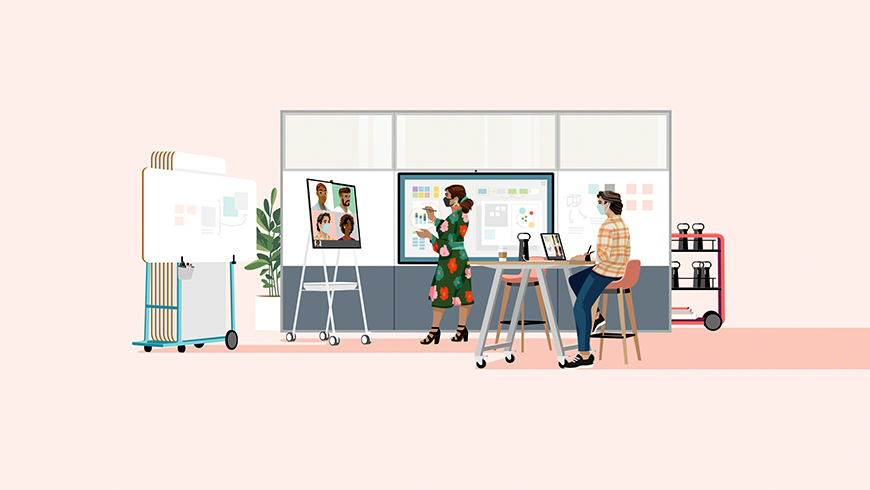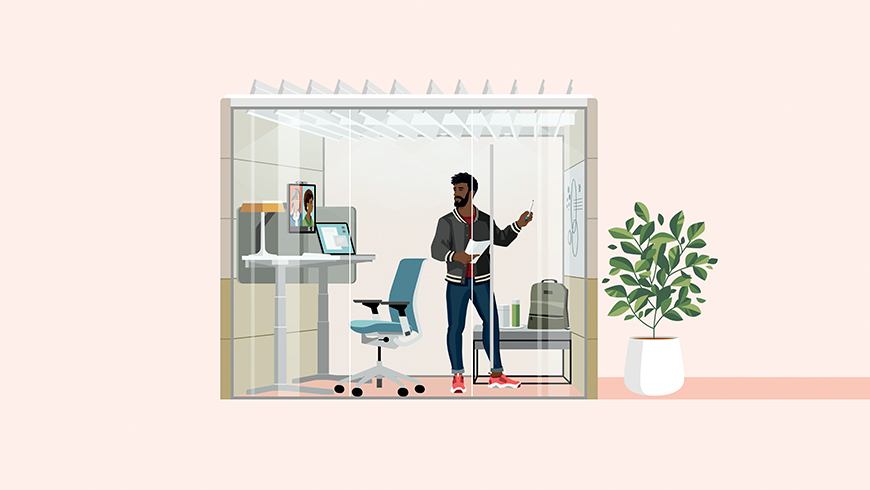The future of the workplace is hybrid and so is the future of collaboration. Sixty-eight percent of global organizations are planning to experiment with hybrid work, allowing employees to work partly in the office and partly at home or a third place to varying degrees. Even companies who will primarily be in the office will encounter hybrid work — some partners, suppliers and customers will expect to connect over distance — and that means people will be collaborating with a blend of remote and co-located teammates more than ever before.
To create the best possible hybrid work experience, organizations will want to offer a range of spaces and technology solutions to easily support diverse types of collaboration — from a planned creative session to an impromptu one-on-one and everything in between.
Steelcase researchers, designers and technology experts have developed collaboration solutions for global teams for more than a decade, aggregating key learnings about how to help teams work across distance. These insights can help organizations prepare for a future in which daily collaboration happens among a blend of co-located and remote participants, using diverse technology and high-performing spaces. Steelcase offers three key concepts to connect in office and remote teams:
EQUITY
Strive for equity and inclusion despite location.
ENGAGEMENT
Design experiences across a range of settings that are human and engaging.
EASE
Design a variety of intuitive virtual and physical experiences that are easy to navigate.
 EQUITY – DESIGN EXPERIENCES THAT ELIMINATE THE GAP OF NOT BEING CO-LOCATED.
EQUITY – DESIGN EXPERIENCES THAT ELIMINATE THE GAP OF NOT BEING CO-LOCATED.
- Enable both remote and co-located participants to move around the room — mobile furniture and displays will help. Remote team members shouldn’t always be “on stage” next to content.
- Use cameras on both shared and individual devices, especially for new teams. Shared devices (room view) should be primary and individual devices secondary.
- Help people feel confident on video by addressing on-camera, task and ambient lighting. Warm, intense LED lights just above head height and off to the side are best for video.
- Consider the space’s size, boundaries, materials and direction of microphones and speakers for the best audio on both ends.
- Develop more intentional shared etiquette and protocols.
 ENGAGEMENT – USE SPACE AND TECHNOLOGY TO FOSTER NATURAL AND INCLUSIVE INTERACTIONS FOR CO-LOCATED AND REMOTE PARTICIPANTS.
ENGAGEMENT – USE SPACE AND TECHNOLOGY TO FOSTER NATURAL AND INCLUSIVE INTERACTIONS FOR CO-LOCATED AND REMOTE PARTICIPANTS.
- Arrange remote and local participants, and digital and analog content to ensure equal participation. Some software platforms and integrated technology systems support the use of multiple displays which allow people and content to be displayed separately which creates a more equitable experience for remote participants.
- Design for the camera’s field of view (i.e. 90, 120 degree). Make sure people and content can be seen by remote participants. AI-powered video conference cameras allow for a wide angle and new ways to enhance analog content virtually. Huddly’s Canvas is one content camera that works with Microsoft Teams and Zoom to improve whiteboard images by removing gloss and shadows, boost marker colors and hide people who might be in front of the camera.
- Use shared content creation tools that provide equal access to digital and analog information and enable multiple modes of collaboration (ex. Digital whiteboards or workspaces like Mural).
 EASE – ENABLE SIMPLE AND SEAMLESS TRANSITIONS ACROSS MULTIPLE INTERFACES, DISPLAYS AND EXPERIENCES.
EASE – ENABLE SIMPLE AND SEAMLESS TRANSITIONS ACROSS MULTIPLE INTERFACES, DISPLAYS AND EXPERIENCES.
- Shared devices should connect easily with personal devices and let people interact with both when necessary.
- Make sure both remote and co-located participants have clean sight lines to people and content. Flexible furniture and/or the use of mobile devices allow you move co-located or remote participants to give them the best view as the meeting evolves.
- The range of technology experiences should work together and pair with a variety of devices and software solutions. While your organization may favor one platform, people making external connections may still need to use a variety of solutions.
Pilot. Participate. Pivot.
As people begin to test out how to collaborate in new ways, technology and the workplace will continue to evolve. It’s a great time to test new types of experiences by setting up a pilot that braids together the physical and the digital. The best advice is to invite employees to participate in any pilot. Participation and open channels for feedback will send a message that nothing is set in stone. And, be prepared to pivot. As people experience the hybrid workplace, they’ll make adjustments to how they are working and their environment, process and protocols will need to adapt as well. A flexible workplace designed to evolve and adapt as people’s needs change will help poise organizations to compete and grow in the future.
Watch a webinar on Hybrid Workplaces
Presented by Steelcase on June 23, 2021: Global leaders in finance, technology and the workplace join the webinar panel to share strategies and learnings about how they are bringing people back to a hybrid workplace.

